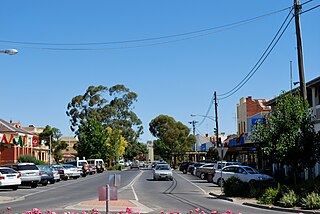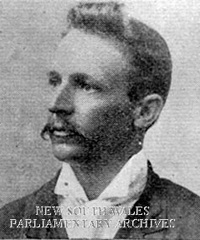
The Burke and Wills expedition was organised by the Royal Society of Victoria in Australia in 1860–61. It initially consisted of 19 men led by Robert O'Hara Burke, with William John Wills being a deputy commander. Its objective was the crossing of Australia from Melbourne in the south to the Gulf of Carpentaria in the north, a distance of around 3,250 kilometres. At that time most of the inland of Australia had not been explored by non-Indigenous people and was largely unknown to the European settlers.
Gary Roy Nairn is an Australian former politician.

The Honorable DrJohn Macadam, was a Scottish-Australian chemist, medical teacher, Australian politician and cabinet minister, and honorary secretary of the Burke and Wills expedition. The genus Macadamia was named after him in 1857. He died at sea, on a voyage from Australia to New Zealand, aged 38.

Kerang is a town on the Loddon River in northern Victoria in Australia. It is the commercial centre to an irrigation district based on livestock, horticulture, lucerne and grain. It is located 279 kilometres (173 mi) north-west of Melbourne on the Murray Valley Highway a few kilometres north of its intersection with the Loddon Valley Highway, elevation 78 metres (256 ft). At the 2016 census, Kerang had a population of 3,893. Kerang is believed to be an Aboriginal word for Cockatoo. It is home to the largest solar and battery farm in the country which was opened in June 2019. The 50-megawatt battery system is located outside of Kerang and stores 100 per cent renewable energy. The 2,000 solar panels have become a tourist attraction and are drawing many businesses to the town.

William John Wills was a British surveyor who also trained as a surgeon. He was the second-in-command of the Burke and Wills expedition, which was the first expedition to cross Australia from south to north, finding a route across the continent from the settled areas of Victoria to the Gulf of Carpentaria. He and the expedition leader Robert O'Hara Burke both died of exhaustion on the expedition's return journey.

John King was an Irish-born British soldier who achieved fame as an Australian explorer. He was the sole survivor of the four men from the ill-fated Burke and Wills expedition who reached the Gulf of Carpentaria. The expedition was the first to cross Australia from south to north, finding a route across the continent from Melbourne in Victoria to the Gulf of Carpentaria in Queensland.

The Royal Society of Victoria (RSV) is the oldest scientific society in Victoria, Australia.
Jamie Morgan is a former professional tennis player from Australia. Morgan never won an ATP level singles title, but finished runner-up three times. He reached the fourth round of the 1993 U.S. Open, his best performance at a Grand Slam event. He achieved a career-high singles ranking of world No. 52 in 1993.
Jimi Bani is an Indigenous Australian actor, known for his portrayal of land rights activist Eddie Mabo in the 2012 tele-movie Mabo, several television series, and theatre performances.
The Surveyor General of Victoria is the person nominally responsible for government surveying in Victoria, Australia. The original duties for the Surveyor General was to measure and determine land grants for settlers in Victoria. The position was created at the time Victoria became a separate colony in 1851.

The RMIT Design Hub is a research, archive, exhibition, and studio space of the Royal Melbourne Institute of Technology in Melbourne, Australia located on the historic Carlton & United Breweries site.

Joseph Bede Kelly was an Australian politician, surveyor, farmer and businessman.

Jesuit Social Services is a social change organisation established by the Australian Jesuits in 1977. Originally based in Melbourne, Australia, it has expanded to include outreach programs in New South Wales and the Northern Territory.

The Burke, Wills, King and Yandruwandha National Heritage Place is a heritage-listed historic precinct on the Birdsville Track, Innamincka, South Australia, Australia. It was added to the Australian National Heritage List on 22 January 2016.
Elizabeth O’Keeffe is a former senior public servant in the State Government of Victoria. She was executive director of Land Victoria from 1996 until 2002 and then the Chief Operating Officer of the National Gallery of Victoria until 2005. After leaving the public service she was a Director of Transparency International Australia until 2013.
Joseph ('Jos') Teresa Florent Jordens (1925-2008) was a Belgian-born Indologist, based in Australia for most of his career.
Dianne Dialecti "Di" Nicolios is a retired Australian Anglican priest. She was the first woman appointed Archdeacon for Women's Ministries in the Anglican Diocese of Sydney. She held that position from January 1994 to May 2002. She was also one of the first group of 14 women to be ordained a deacon in 1989 in the Sydney diocese.
Benjamin Bargwanna is a racing driver from Australia. He is the son of Bathurst 1000 winner Jason Bargwanna and grandson to Australian Production Car Champion Harry Bargwanna.
The Institution of Surveyors Victoria (ISV), formerly known as the Victorian Institute of Surveyors, was established in 1874. ISV is the oldest professional surveying body in both Victoria and Australia operating continuously since its formation.
















